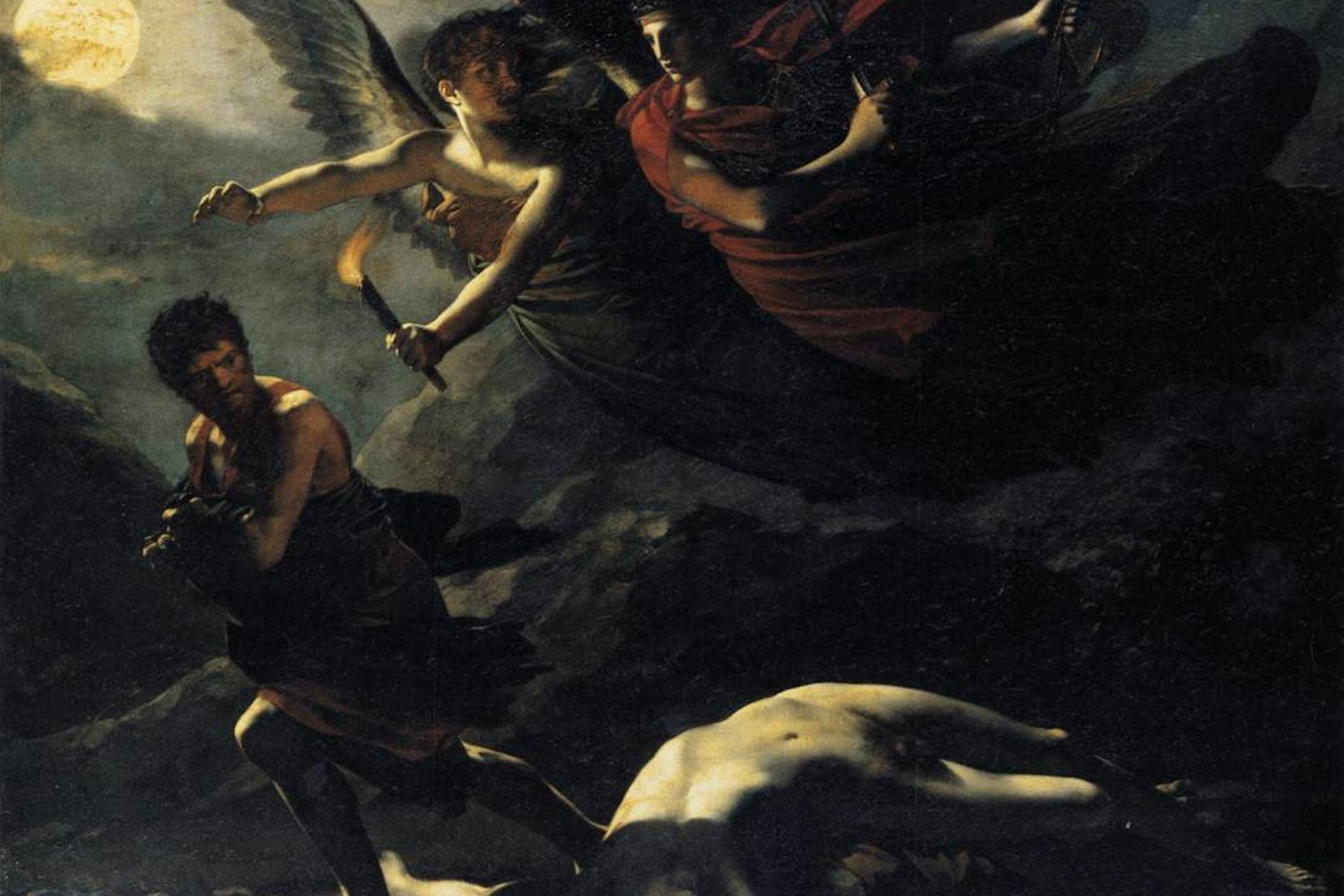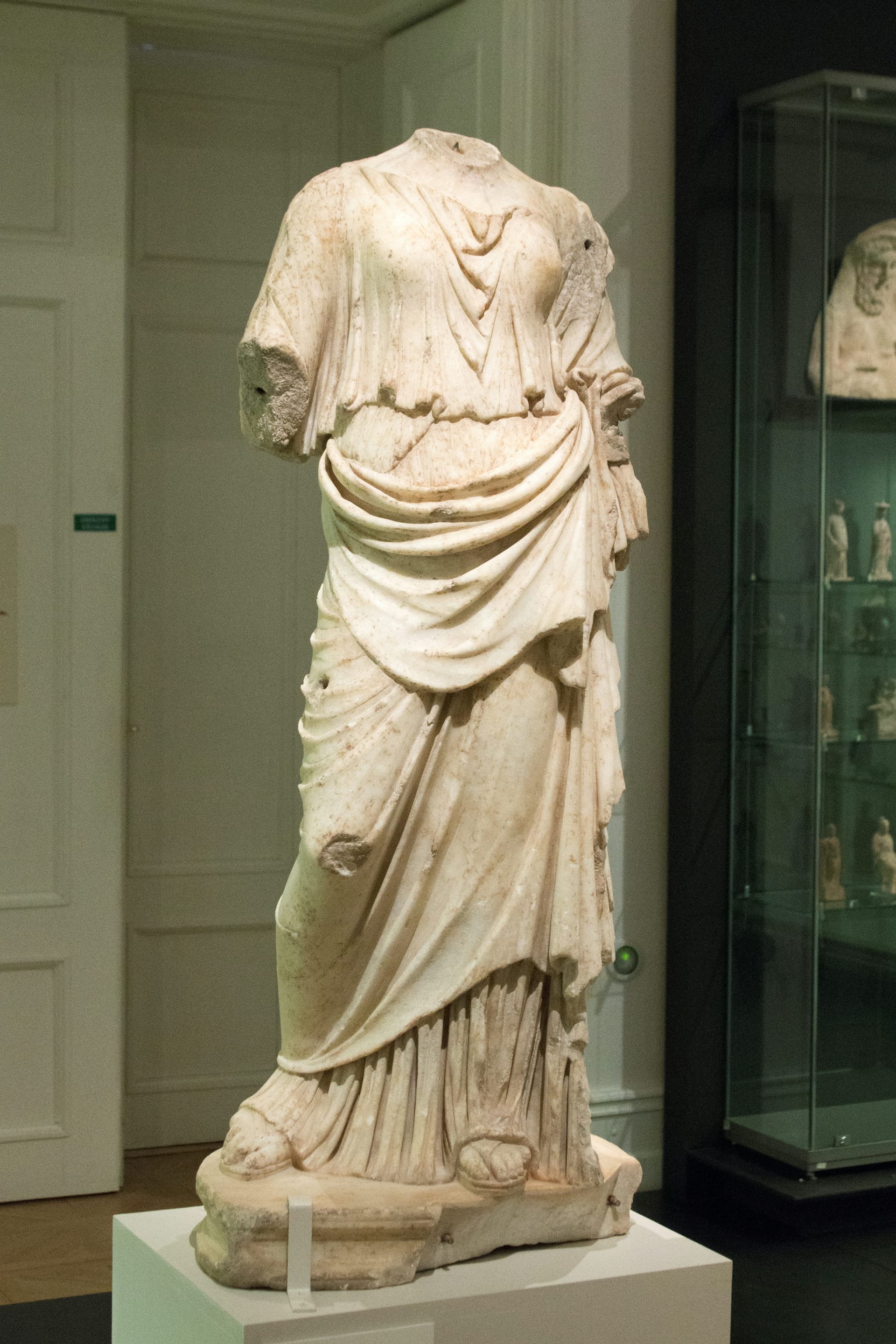Nemesis

Justice and Divine Vengeance Pursuing Crime by Pierre-Paul Prud'hon (1808).
Louvre Museum, Paris, FrancePublic DomainIntroduction
Nemesis was a goddess and personified moral agent, the spirit of “retribution.” She represented the punishments suffered by those who committed injustice, those who violated the established laws, or those guilty of hybris against the gods. But Nemesis could also represent more destructive anger and vengeance. She was typically regarded as the daughter of Nyx, the primordial personification of night, yet there were other traditions about her parentage too.
In literature and art, Nemesis was represented with the symbolic trappings of justice, including the all-measuring rod and scales. Her mythology was limited, but she was worshiped throughout the ancient Greek world as a goddess associated with justice and fate, but her earliest cults were Ionic.
Etymology
The name “Nemesis” (Greek Νέμεσις, translit. Némesis) is often connected with the Greek verb νέμω (némō), meaning “distribute, attribute;” it may ultimately come from an Indo-European root *nem-, “attribute.”[1]
Pronunciation
English
Greek
Nemesis Νέμεσις (Némesis) Phonetic
IPA
[NEM-uh-sis] /ˈnɛm ə sɪs/
Alternative Names and Epithets
Nemesis was sometimes identified with other goddesses of fate and justice, and could thus be known by a handful of alternative names. One of her more important alternative names was Adrasteia, probably from the Greek word meaning “inescapable” (though some connected the name to the hero Adrastus). Nemesis was sometimes also known by the epithet Rhamnusia or Rhamnusis, from her important cult in the town of Rhamnus in Attica.
Attributes
Functions and Characteristics
Nemesis was the goddess who personified retribution and righteous anger. She was responsible for punishing wrongdoing. Above all, she was concerned with dispensing justice to those who had committed hybris or insolence towards the gods;[2] but she also punished other kinds of mortal wrongdoers, including those who behaved unjustly towards other mortals[3] or even towards the dead.[4]
Nemesis could be an ambivalent goddess, with positive and negative aspects. In his Works and Days, Hesiod connected Nemesis with Aidos, “shame” personified, as a positive force originally sent to mortals to keep their unruly impulses in check; at the time of the impious “Age of Iron,” the two goddesses withdrew from the earth, leaving mortals to their suffering.[5] According to Hesiod’s Theogony, on the other hand, Nemesis’ mother Nyx (“Night”) sent Nemesis to mortals to cause them suffering, as the negative force of destructive anger.[6]
Ancient sources emphasized the vigilance of Nemesis. Nemesis was described as merciless,[7] all-seeing and all-hearing,[8] and resentful of good fortune.[9] She had wings with which to better pursue wrongdoers.[10] Over time, as Nemesis became an all-encompassing symbol of justice and of the enforcement of justice,[11] she was placed somewhere above the stars and envisioned as clinging to the tracks of the wicked and bending their necks.[12]
Nemesis also acquired symbols representing her role as judge, punisher, and avenger: an all-measuring rod or ell, reins and bridle, a dagger or sword, and sometimes scales.[13] Nemesis was also connected with animals, especially the mythical griffin, and this aspect (among others) suggests that she was viewed as a chthonic deity—that is, a deity connected with the powers of the earth and Underworld.[14]
As Nemesis became more and more popular, she became associated with a handful of other gods and goddesses, including Artemis, Themis, Tyche (“Chance”), and Nike (“Victory”). Plato described her as the messenger of Dike, “Justice” personified.[15] And she was often identified with the obscure goddess Adrasteia, another deity representing justice and fate.[16]
Iconography
Nemesis was present in ancient art from the fifth century BCE (if not earlier), and became especially popular by the second and third centuries CE. She was typically depicted as rather generic in appearance, as an attractive goddess, sometimes resembling a clothed Aphrodite. She was often winged. In her important cult statue at Rhamnus, which some claimed was originally conceived as a statue of Aphrodite, Nemesis was shown clad in a drake chiton and cloak, wearing a crown engraved with stags and figures of the personification Nike (“Victory”), and holding an apple branch and a bowl.[17]

First or second century CE Roman copy of the cult statue of Nemesis by Phidias or Agoracritus that once stood in the Temple of Nemesis in Rhamnus. Kinský Palace, Prague, Czech Republic.
Wikimedia CommonsCC BY-SA 4.0Because her physical appearance could be generic, Nemesis is most easily distinguished by her symbols and attributes. The symbols of Nemesis represented her role as a goddess of justice and fate: a rod or ell, reins and a bridle, a wheel, scales, and a sword or dagger. Her animal was the griffin, a creature that was part-lion and part-eagle.[18]
Family
According to Hesiod, Nemesis was one of the fatherless children born to the primordial goddess Nyx, “Night” personified; her siblings thus included other dark cosmic forces such as Thanatos (“Death”), Hypnos (“Sleep”), Eris (“Strife”), and the Moirae (“Fates”), among others.[19] This was no doubt the most widespread and familiar tradition about the goddess’ parentage, but it was not the only one that existed. In her important cult in Rhamnus, Nemesis was worshiped as one of the daughters of the Titan Oceanus—that is, as one of the “Oceanids.”[20] In another tradition, she was the daughter of Zeus (or Zeus and Demeter).[21] And in Mesomedes’ Hymn to Nemesis she was the daughter of Dike, the personification of justice.[22]
Ancient tradition did not give Nemesis a husband. In one popular myth, however, Nemesis was pursued by the amorous Zeus, and from their union was born the beautiful Helen (who in other accounts was the daughter of Zeus and the mortal Leda);[23] in some variations of this myth, it seems that Nemesis was also the mother of Helen’s brothers Castor and Polydeuces, the so-called Dioscuri.[24]
According to Bacchylides, Nemesis also lay with the primordial god Tartarus, and by him became the mother of the Telchines, mysterious sorcerer deities of the island of Rhodes.[25]
Mythology
Like many other personified deities, Nemesis had a very limited role in mythology. One well-known story, however, told of how Zeus, the ruler of the Olympian gods, fell in love with Nemesis. Nemesis tried to escape Zeus’ advances by changing into various animals to escape. Finally, Nemesis changed herself into a goose (or a swan); Zeus did the same, caught up with Nemesis, and raped her.
Soon, Nemesis laid an egg, which was discovered or given to the Spartan queen Leda. From the egg was born Helen, who would become infamous for being the cause of the Trojan War, and perhaps also Helen’s brothers Castor and Polydeuces.[26]

Leda and the Swan by Cesare de Sesto after Leonardo da Vinci (ca. 1505–1510). Wilton House, Salisbury, UK.
Wikimedia CommonsPublic DomainIn another story, Nemesis played a role in the myth of Aura. Aura was a virgin nymph and a companion of Artemis. One day, the foolish Aura poked fun at Artemis: she said that no woman or goddess with Artemis’ curvy body could be a virgin, adding that her own lean and boyish figure left no doubt as to her virginity. Artemis was furious. She went to Nemesis to demand retribution, and Nemesis, wishing to make the punishment fit the crime, went on to make Aura lose the virginity in which she took so much pride. Nemesis had Eros, the god of love, cause Dionysus to fall in love with Aura. When Aura resisted Dionysus’ advances, Dionysus got the nymph drunk and raped her when she fell asleep.[27]
Worship
Temples
The worship of Nemesis appears to have originated among the Ionian Greeks, but eventually became reasonably widespread throughout the ancient world. One of the most important sanctuaries of Nemesis was at Rhamnus in Attica. In some traditions, this was the site where Nemesis was raped by Zeus.[28] The sanctuary at Rhamnus was built in the early fifth century BCE after the Persians had sacked Athens. The cult statue of Nemesis that stood in this temple—of which some fragments and a handful of replicas still survive—was created by either Phidias or Agoracritus.[29]
There was another important cult of Nemesis at Smyrna, a Greek city on the coast of Anatolia (modern Turkey). At Smyrna, Nemesis was worshiped as a dual being.[30] The theological reasoning behind this duality is unclear. Perhaps the two Nemeses represented the two sides of the goddess: one a positive and kindly force, the other negative and merciless (compare the two sides of Nemesis’ sister Eris).
In the Peloponnese, it was said that the worship of Nemesis was first introduced by the Argive hero and king Adrastus, one of the leaders of the Seven against Thebes. Because of this—at least according to some authorities—Nemesis was sometimes called “Adrasteia,” after Adrastus.[31] While Nemesis was sometimes identified with and worshiped as Adrasteia, the two goddesses were sometimes considered to be distinct (though still connected). On the island of Cos, there is evidence for a joint cult of Nemesis and Adrasteia.[32]
Nemesis was also associated with other gods and goddesses. At Rhamnus, for example, Nemesis may have been worshiped alongside Themis[33], and at Cirrha near Delphi there was a statue of Nemesis in a temple of Apollo, Artemis, and Leto.[34]
The worship of Nemesis soon spread beyond the Greek world. In Rome, Nemesis was one of the tutelary deities of the drill ground and arena, and there was even a statue of Nemesis on the Capitoline Hill at the heart of Rome.[35] The Romans seem to have associated Nemesis above all in connection with the imperial power and its power to distribute justice and punishment.[36]
There were other temples of Nemesis scattered across the Greek and Roman world, at sites such as Patrae in the northwestern Peloponnese,[37] at Cyzicus in northern Anatolia (where Nemesis was worshiped as Adrasteia),[38] and perhaps also at Alexandria.[39]
Festivals
Festivals and celebrations of Nemesis were an important part of some of her cult sites. At the sanctuary of Nemesis in Smyrna, Nemesis was honored with athletic games.[40] At Athens, there was an annual festival called the Nemeseia (perhaps identical with the Genesia) held during the summer. Little is known about the Nemeseia, but the object seems to have been to avert the anger of the dead, who were believed to have the power to harm the living if they were not properly honored.[41]
Pop Culture
Today, the name of the goddess Nemesis is most commonly encountered as a colloquial term for an archenemy. As a Greek goddess, Nemesis occasionally appears in modern adaptations of Greek mythology. Nemesis is a fairly important supporting character in the TV series Hercules: The Legendary Journeys and its “spinoff” Young Hercules, where she is the executioner of the gods and Hercules’ first love.